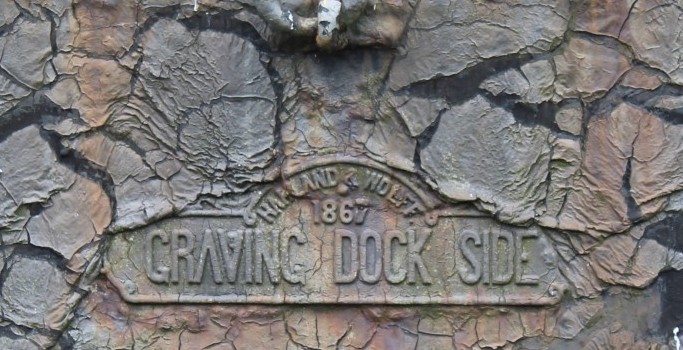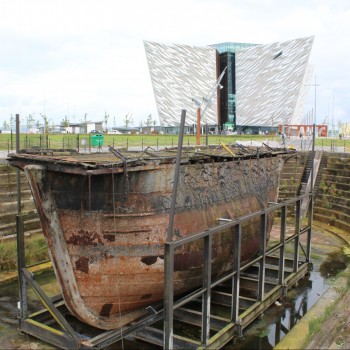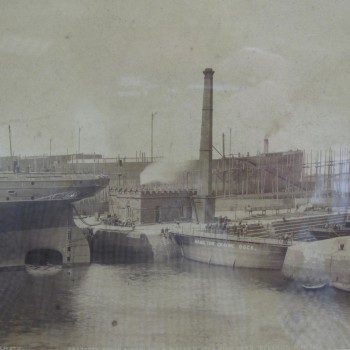The Hamilton Dock and the Caisson Gate
Built in 1867, the Caisson gate is one of the oldest remaining Harland Wolff constructions, and is actually a vessel, given the hull number 50 in H&W’s shipping register.
A historic dock and gate
The Hamilton Dock is the oldest graving dock on this side of the river Lagan, built between 1864 and 1867, on the newly created Queens Island. Formed from the excavation works and straightening of the River Lagan, Queens Island was originally a timber pond and small pleasure garden. The Harbour Commissioners were keen to use the island commercially and built an innovative patent slip, which encouraged the shipbuilders Thompson & Kirwin to move their small shipyard there in the 1850s. Robert Hickson set up an iron shipyard there in the 1853, which would be bought a few years later by Edward Harland and form the beginnings of the largest shipyard in the world.
The Harbour Commissioners needed to improve the infrastructure for the busy shipyards, and agreed to build a large floating dock on the Co Antrim side – the Spencer & Dufferin Docks, and in 1867 completed the Hamilton Dock and Abercorn Basin on the Co Down side. The new improvements to Queens Island attracted another shipbuilding firm, MacIlwaine and Lewis, to set up near the Abercorn Basin in 1867, and by 1869 Harland Wolff had acquired the Thompson and Kirwin shipyard as well, gradually expanding the yard.
The Hamilton Dock is now listed as a historic scheduled monument, and for more than 120 years it was used for repairing, maintaining and fitting out ships. The small pumphouse at the Abercorn Basin end of the dock still contains the original pumping machinery, though the chimney has long been removed.
The Caisson is the original dock gate and sits at the other end of the Hamilton dock to the Nomadic, long since replaced by a new permanent gate. Built in 1867, the Caisson is one of the oldest remaining Harland Wolff constructions, and is actually a vessel, given the hull number 50 in H&W’s shipping register. A hollow vessel built from wood and steel, its job was to stop water from going in or out of the Hamilton Dock. It would have been flooded to close the dock or emptied to float it and allow it to be towed clear of the dock.
The Hamilton Dock was last used in the 1990s, and had fallen into disrepair following the decline in shipbuilding in Belfast. Harland and Wolff had seen decades of falling orders and a reduced workforce, and in 1977 was nationalised by the British government. Further declines saw the shipyard reach an impasse, and in 1989 the government sold the yard to an employee management buyout in partnership with Fred. Olsen, the Norwegian shipping magnate. The majority of the land on the riverside of the Queens Road was abandoned as the shipyard contracted to the Building Dock and Samson & Goliath cranes. The last ship built by Harland and Wolff was the Anvil Point, launched in 2003.
The black and white image above shows the Caisson gate in use when the SS Majestic was being completed around 1889-90. The Caisson remains in the ownership of Belfast Harbour.
The Maritime Belfast Trust acquired the lease for the Hamilton Dock alongside the transfer of the SS Nomadic in April 2015.


